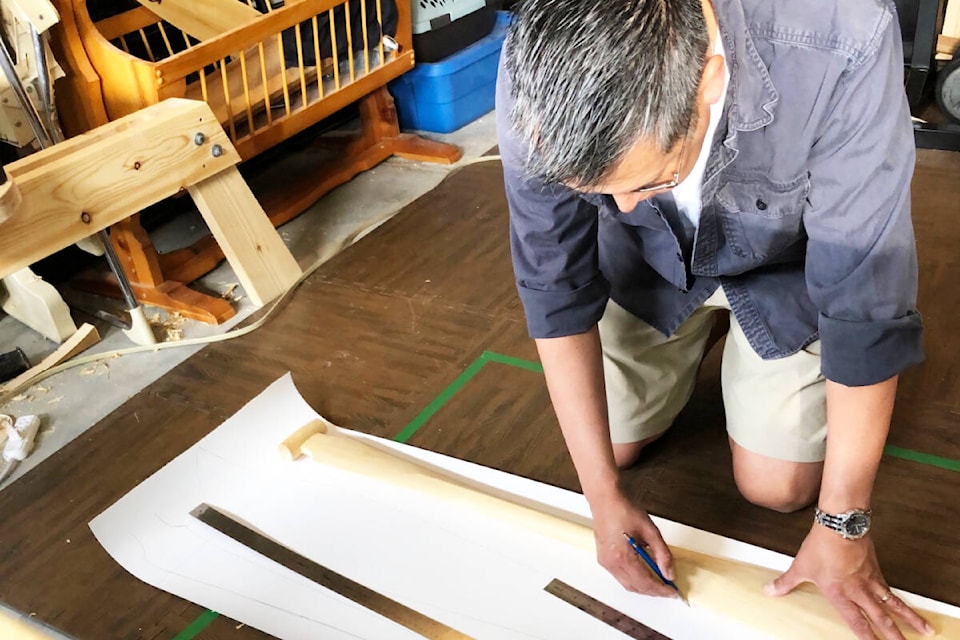An accomplished Haida artist with a 20-year career in law and Indigenous and settler ancestries, Keith Kerrigan didn’t always feel like he belonged. Still, he carved out his own space in the world and used his unique life experiences to help others.
One of his recent endeavours was helping to develop the concept for the Pillars of Hope and Strength, which will be erected in Prince Rupert and Prince George later this year.
The project, led by Highway of Tears Governing Body and Carrier Sekani Family Services, is meant to commemorate the Indigenous women and girls who have been murdered and gone missing from this stretch of northern B.C.’s Highway 16.
This is just one way Kerrigan’s unique life experiences have made him well-suited.
Kerrigan’s interest in art started in childhood.
Born to a Haida mother and English father, he didn’t grow up in Haida Gwaii, but his family visited in the summers.
When he was a teenager, his uncle, Claude Davidson, enrolled Kerrigan and his brother in a Haida design and argillite carving course.
Art was always just around, Kerrigan said.
“If you see how something’s done, you see somebody you know doing it, it just kind of makes it real, it makes it possible for you.”
Even when he went away to school to study finance and law, he continued to develop his carving skills. He moved from argillite to wood, eventually gold and silver, with his cousins Reg Davidson and Robert Davidson guiding him.
He had a dual career excelling in both art and law.
There is a theory that people use different sides of their brain for artistic and creative thinking versus analytical and methodical thinking, he said, but Kerrigan doesn’t believe it.
“When I spent 20 years working as a lawyer, in order to solve problems, you have to be creative, find solutions within the options that are out there. So I’ve never looked at that as being anything but something that I was comfortable doing, whether it was working as a lawyer or working as an artist.”
Kerrigan just wanted to help people and he felt he could do that in both pursuits.
It made it difficult, though, to know where he belonged.
He used to wear Wingtip shoes to work. Footwear he described as “what you’d see a lawyer or banker wear, with a fancy, sort of rippled edge.” Most of his Wingtips were black, but he had one pair that was cognac, a reddish-brown colour, he told The Haida Gwaii Observer.
Kerrigan said when he wore that cognac pair to his law office, the other lawyers would tell him, “You’re wearing your artist shoes.”
Then, when he wore them at an event with other artists, his fellow creatives would tell him he had on his lawyer shoes.
Each group saw him as the other.
It was a similar feeling he got being both Indigenous and non-Indigenous. He belonged to both and neither community at the same time.
He left law and became a full-time carver after a health scare forced him to re-evaluate his priorities.
Now he primarily creates contemporary jewellery, engraving Haida designs in gold and silver.
For his custom pieces, he talks to the client to learn about their history and reasons for commissioning the work. Then he chooses a Haida story relevant to who they are, developing a unique design that blends the narratives.
Kerrigan said he enjoys the problem-solving aspect of creating something meaningful for someone else, but there is something extra special about the art he makes for himself.
“When I’m doing a show, I can tell you which [pieces] people are going to be most interested in, and it’s the ones that I’ve chosen to make because I wanted to make them.”
To explain why the work he does for himself is different, Kerrigan said to imagine there is a guitar in the room and someone across the room is playing another guitar. Despite not being strum, the silent guitar resonates across the room.
“There’s a connection there. We can see that it’s scientific. We can see the science behind it. But there’s a similar connection when people are feeling what you’re doing as an artist.”
A part of him resonates in the work when he makes it for himself.
While Kerrigan did not always feel like he belonged, his unique experiences made him the perfect fit to sit as board chair for Emily Carr University.
Upon being appointed in September 2021, the University stated that “he brings a valued perspective as a professional artist who has worked in both law and business.”
How can he make a difference in this position? This was the question he had for himself. In the end he said he realized that it’s not really about what he could do, it’s about what the community can do.
Kaitlyn Bailey | Local Journalism Initiative Reporter
Send Kaitlyn email
Send The Observer email
Like the Haida Gwaii Observer on Facebook
Follow us on Twitter
